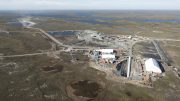Glencore’s surprise decision to cut back its copper production coupled with stronger-than-expected Chinese copper import data have had a salutary effect on copper prices, which jumped 5% on Sept. 8 to record their biggest one-day percentage gain in two and a half years to US$2.43 per lb. at press time.
That’s a 9.5% rise from the near seven-year low of US$2.22 per lb. seen a little over two weeks earlier on Aug. 24, 2015. For context, that’s still well above the recessionary low of just US$1.26 per lb. on Dec. 24, 2008, but nowhere near the sweet, sweet record-high price of US$4.60 per lb. on Feb. 14, 2011.
In some ways, copper’s price gyrations have mirrored that of crude oil, which saw sudden price gains of 27% over three days in late August on lower U.S. production estimates, and expectations of supply cuts from other producing countries.
In light of what it calls the “challenging environment for commodities,” Glencore has had its subsidiaries Katanga Mining in the Democratic Republic of the Congo and Mopani Copper Mines in Zambia launch a major review of their copper-mining businesses, and suspend production at both Katanga and Mopani operations for 18 months until finishing expansion and upgrade projects that will continue to get funding, including the whole-ore leach at Katanga and the new shafts and concentrator at Mopani.
Glencore says these suspensions could remove 400,000 tonnes of copper cathode from the market, or 1–2% of world copper production. It also expects the expansion and upgrade programs will reduce C1 costs at Katanga and Mopani to US$1.65 per lb. and US$1.70 per lb., from more than US$2.50 per lb. today.
Glencore’s Mutanda Mining copper mine in the DRC will continue operating, where it is achieving C1 costs of only US$1.33 per lb.)
Back at head office, Glencore management is shoring up its balance sheet to stave off a cut in its credit rating, which stands at BBB at Standard & Poor’s. One of the key moves for Glencore will be to sell US$2.5 billion in new shares to help pay down its US$30-billion debt load.
By many analysts’ calculations, Glencore’s bold move could restore supply-demand balance to the global copper market, which has been in oversupply this year by perhaps 500,000 tonnes, as the Chinese economy has slowed faster than most had expected.
And yet, the latest data has revealed copper imports by China, which accounts for 40% of the global demand for refined copper, rose 2.9% year-over-year to 350,000 tonnes — flat compared to July 2015 levels but still better than expected.
These two positive events for copper have effectively ended several months of extreme bearishness in copper markets that was little moved by the first news of substantial cuts announced by Freeport-McMoRan on Aug. 27 that were more geared towards reducing capital expenses than cutting production.
At any rate, the copper industry is showing greater supply discipline by its biggest producers than is being displayed by the giant miners of the iron ore business — notably BHP Billiton and Rio Tinto — who refuse to pull back on their record levels of ultra low-cost iron ore production in Western Australia that have devastated iron ore prices, and wrecked the balance sheets of higher cost producers worldwide.
Indeed, Glencore CEO Ivan Glasenberg famously peppered his speeches last year with condemnations of the iron ore majors for flooding the market with iron ore, and said that Glencore was “lucky” for not being in the iron ore business — presumably a reference to Glencore’s failed approach in acquiring Rio Tinto in previous years.
The next major influence on copper prices will perhaps be the decision in the coming months by the U.S. Federal Reserve on whether to increase interest rates, which would likely lead to a stronger U.S. dollar and lower prices for commodities priced in U.S. dollars.




Be the first to comment on "Editorial: Signs of life in copper market"